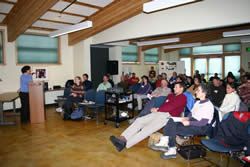
National Fire Plan Success Story
Symposium Offers Forum Sharing Monitoring, Project Results
Grand Teton National Park / Bridger-Teton National Forest, Wyoming
National Fire Plan - Accountability
2008

NPS Ecologist Kelly McCloskey reports whitebark pine beetle study findings at the Teton Interagency Fire Effects Symposium.
More than 60 people from four states braved blizzard conditions to attend the sixth Teton Interagency Fire Effects Symposium February 7, 2008 in Jackson, Wyoming. The symposium provides an opportunity for fire managers, researchers and resource managers from different agencies to examine monitoring results from projects in a peer-reviewed forum.
Representatives from the National Park Service, U.S. Forest Service, Bureau of Land Management, U.S. Fish and Wildlife Service, Wyoming Game and Fish Department, the U.S. Geological Survey, and local conservation organizations attended the sessions.
"This symposium allows us to share results from local and regional vegetation and fire effects monitoring to capitalize on what we learned and improve fire management," said Diane Abendroth, Grand Teton National Park fire effects monitor and one of the symposium's organizers. "Forums like this help keep us educated on hot topics and potential challenges that we face. By keeping informed, we can adapt fire management as necessary, which will keep us from becoming outmoded."
While attendees gave high marks to all topics presented, the whitebark pine research, snowshoe hare habitat, sage grouse study, and recent burn project discussions drew the most attention.
"These are all timely issues," Abendroth said. "We learned that ideal snowshoe hare habitat means significant ladder fuels. In order to provide a prey base for lynx, we need to be careful where we conduct fuels treatments. We heard findings from a sage grouse habitat study that indicates we should collect monitoring data on sagebrush height."
Interagency Fuels Specialist Mack McFarland said the symposium provided an avenue for federal agencies to step back from implementing fire management, take a broad look at the landscape, and analyze some results from past projects.
"The Fire Effects Symposium brings fire and resource managers together to present their project results, which creates a greater understanding of what each group is doing and hopefully encourages a more unified approach to dealing with some of these important issues," McFarland said.
Contact: Traci Weaver, Fire Communication and Education Specialist; phone: (307) 739-3692.